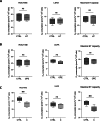Phenolic extract from olive mill wastewater sustains mitochondrial bioenergetics upon oxidative insult
- PMID: 39791008
- PMCID: PMC11713508
- DOI: 10.1016/j.fochms.2024.100234
Phenolic extract from olive mill wastewater sustains mitochondrial bioenergetics upon oxidative insult
Abstract
In the last few years, many efforts have been devoted to the recovery and valorization of olive oil by-products because of their potentially high biological value. The olive mill wastewater (OMWW), a dark-green brown colored liquid that mainly consists of olive fruit vegetation water, is particularly exploited in this regard for its great content in phenolic compounds with strong antioxidant properties. In our previous work, we produced different OMWW fractions enriched in hydroxytyrosol- and hydroxytyrosol/oleuropein (i.e. C and OPE extracts, respectively) that exhibited considerable anti-microbial and radical-scavenging activities in vitro. Based on these findings, the present study aimed to assess the impact of C and OPE samples on mitochondrial function and oxidative stress response in mouse fibroblast-like cells (NCTC). Accordingly, OMWW phenolic extracts proved to enhance mitochondrial biogenesis and to reduce cellular sensitivity to hydrogen peroxide. Moreover, high-resolution respirometry experiments first time revealed the efficiency of OMWW phenols recovered by selective resin extraction in preventing mitochondrial respiration failure upon oxidative insult. Collected data definitely demonstrate the bioactivity of our phenolic-rich fractions, supporting the advantages of reusing the olive mill wastewater to generate, at low-cost, high added value molecules that could be useful for the improvement of health and nutrition products.
Keywords: Mitochondrial biogenesis; Mitochondrial respiration; Oil waste recovery; Oxidative stress; Phenolic compounds.
© 2024 The Authors. Published by Elsevier Ltd.
Conflict of interest statement
The authors declare that they have no known competing financial interests or personal relationships. that could have appeared to influence the work reported in this article.
Figures







References
-
- Bigagli E., Cinci L., Paccosi S., Parenti A., D'Ambrosio M., Luceri C. Nutritionally relevant concentrations of resveratrol and hydroxytyrosol mitigate oxidative burst of human granulocytes and monocytes and the production of pro-inflammatory mediators in LPS-stimulated RAW 264.7 macrophages. International Immunopharmacology. 2017;43:147–155. doi: 10.1016/j.intimp.2016.12.012. - DOI - PubMed
LinkOut - more resources
Full Text Sources

